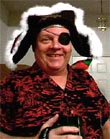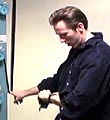|
|
This topic comprises 2 pages: 1 2
|
|
Author
|
Topic: ? about slide film developing at home
|
|
|
|
|
|
|
Don Bruechert
Mmmmmmmmm, bird!

Posts: 340
From: Manitowoc, WI, USA
Registered: Jan 2003
|
 posted 07-23-2003 09:00 AM
posted 07-23-2003 09:00 AM





Sam,
I used to have my own darkroom and do a lot of film processing and printing. I was developing and printing both B&W ad Slide film, and I was also rolling my own from 100 foot rolls, which can save you a lot of money if you are really into shooting film.
All of the info provided thus far is excellent. I will say I definately prefer the changing bag to a dark room for loading my film onto reels for two reasons: First is that you can use it anywhere, even in front of the TV while watching the game, and the second is that without spending a lot of time or having a permanent location you can never be sure your room is completely "dark" every time, and film is a lot more sensitive to any amount of light than paper is (for printing). The changing bag seals everything up inside of two dark bags (one inside the other) and has two tight-sealing armholes in it so you can work inside. Once you get used to it you can do everything by feel anyway. Cost - about $18.
Next, we get to the chemistry. I have used the Kodak kit, and like it, but I find it to be more expensive if you are planning to develop a lot of film. On thing you need to know is that the chemicals, once mixed, are only good for about a maximum of 6 weeks (or 6 rolls of slides, whichever comes first). If you don't shoot a lot of film, save up the rolls until you have a bunch of them and try to process them within a few weeks. The longer/more time the chemistry is exposed to the air the weaker it gets - that's why the 6 week time limit. I used to use Jobo chemicals - their kit was called Photocolor E6 and it was a 5 liter kit. You mixed up a batch that was good for 6 rolls (or 6 weeks) as needed and it was cheaper because it was in larger quantities.
Keeping temperatures. Temperatures are critical for proper slide film processing and any slight variation will affect the processing times. If you do this a while (and make mistakes) you will find a proper rhythm that works for you. GET AN EXCELLENT THERMOMETER - Do Not Skimp. Slide processing works best at 100 degF and you are supposed to keep everything at that temp the entire time. FOR ME, I have found that filling a dishpan with 110 deg water and letting EVERYTHING soak in there before starting works best. Use your thermometer and wait until your first developer warms up to 101 deg and then start processing. There will be a sligt temperature loss when you pour them chemicals into the film tank so this helps a bit. Keep your water bath WARMER than your processing temperature so the temps stay up, but not so warm as to raise the temp inside the tank while developing. I found the gradual cool off from 110 deg during the development time worked good for me. Your tank will also lose heat when you remove it from the water bath to agitate the chemicals. The rest of the chemicals are not AS temperature sensitive as the developer stage.
I recommend adding Kodak Photo-Flo to your final rinse per the directions on the bottle. This is a surfactant that will help the film to dry properly.
A couple final things. Start your processing experience with 24 exposure rolls. 12's are too short and waste 1 hit on your chemistry, and you will find 36 exposures tend to drag on the floor when trying to find a place to hang them to dry because they are so long - find a nice, lint and dust free place where the film can hang to dry undisturbed. I recommend Pakon plastic slide mounts - they are quite easy to use, and reusable if necessary. Buy the kit the first time - it comes with a cute little plastic tool you can use to load them.
After you do it a few times you will really like it - it is not really as hard as it seems. HAVE FUN - hope this wasn't too long. ![[Smile]](smile.gif)
| IP: Logged
|
|
|
|
|
|
Stephen Furley
Film God

Posts: 3059
From: Coulsdon, Croydon, England
Registered: May 2002
|
 posted 07-23-2003 11:02 AM
posted 07-23-2003 11:02 AM




I do quite a lot of E6, rolls and sheets. It's not difficult, just take care, and follow the instructions exactly. All normal colour slide films, except Kodachrome are now E6 compatible, and have been for years. Fuji call theirs something different, (CR56?) and I think Agfa have a different number, but they're all compatible.
You do need quite a high temperature, most kits use 38C, 100F, I have a thermostatic water bath, which helps.
Make sure you have somewhere dust free for drying.
You generally get more films per unit of chemistry, and save time, if you process several films at once. I use the Tetanal 6 bath kit, make up 1 litre at a time, and that will do four 35mm films at once in a stainless steel tank, or three in a plastic one. One Litre is supposed to be good for 12 rolls (36 exp.), but if I always do a full tank, I find I can do 14 or 15 with no loss of quality (Kodak control strips put through and checked on densitometer).
Make sure bottles for first and colour developers are kept full, add marbles or cover the solution with an inert or reducing gas, available in aerosol cans, for maximum storage life.
Keep everything clean, avoid contaminatination of chemicals, espically colour developer.
Should be obvious, but observe sensible precautions, don't eat, drink or smoke while handling chemicals, keep them away from children etc.
Be careful with the colour developer, I used to be able to soak my arms in the stuff for hours on end when I was doing colour printing, then suddenly, about fifteen years ago, I got alergic to it, and now the shightest splash on my skin will bring me up in a very nasty rash.
The first film I ever processed was colour slides, in the old E2 process, which took absolutely ages! I didn't even have a tank, I used to see-saw the film through dishes of chemicals - how things have changed, in this case for the better. ![[Smile]](smile.gif)
| IP: Logged
|
|
|
|
|
|
|
|
|
|
|
|
|
|
|
|
|
|
|
|
All times are Central (GMT -6:00)
|
This topic comprises 2 pages: 1 2
|
Powered by Infopop Corporation
UBB.classicTM
6.3.1.2
The Film-Tech Forums are designed for various members related to the cinema industry to express their opinions, viewpoints and testimonials on various products, services and events based upon speculation, personal knowledge and factual information through use, therefore all views represented here allow no liability upon the publishers of this web site and the owners of said views assume no liability for any ill will resulting from these postings. The posts made here are for educational as well as entertainment purposes and as such anyone viewing this portion of the website must accept these views as statements of the author of that opinion
and agrees to release the authors from any and all liability.
|

 Home
Home
 Products
Products
 Store
Store
 Forum
Forum
 Warehouse
Warehouse
 Contact Us
Contact Us




 Printer-friendly view of this topic
Printer-friendly view of this topic






![[Big Grin]](biggrin.gif)



![[Smile]](smile.gif)







